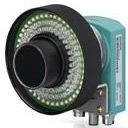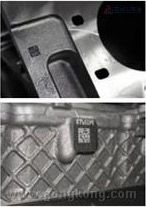Today's car ordered by a customer is assembled from a complete set of well-documented parts. Personalized production control is unimaginable without the identification of parts. Prerequisites for complete component information are two-dimensional matrix codes and high-performance readers. In addition to product quality requirements, product tracking and component information tracking related to market strategy are receiving more and more attention.
This article refers to the address: http://
Introduction to Siemens SIMATIC MV440 Reader
A one-dimensional code/two-dimensional code is a graphic identifier that is arranged according to a certain encoding rule to express a set of information. Mainly used for product traceability, production control, automatic identification, especially one of the hardware systems that constitute the "Internet of Things" together with the emerging RFID technology.
One-dimensional code: the so-called "barcode", we can find all kinds of products in the current circulation of all goods, such as supermarkets.
QR code: An upgraded version of the 1D code. Because it can contain more information and higher readability than one-dimensional code, two-dimensional code is currently used on more and more products.
Character: Contains Arabic numerals and letters. The characters on the general package indicate the batch number and date of manufacture.
The SIMATIC MV420/MV440 is a code reader device designed for industrial applications and is a reading device for reading 1D/2D codes in industrial environments. Generally, the one-dimensional/two-dimensional code on the product and the outer package is read on the production line to realize the control of the production process.
Siemens MV440/MV420 technology / features:
main feature:
â– IP67's high degree of protection against vibration and shock resistance for a variety of harsh industrial environments
â– A variety of optional parameters
– resolution 640 x 480, 752 x 480 or 1024 x 768 pixels
– Optional "check" function
– can be connected to an external light source
â– High reading speed
– Special decoding algorithm "ID-Genius"
– up to 80 reads per second
– Up to 14 teaching code types can be stored
– Multi-code simultaneous reading function
â– Communication interface
– Direct connection to PROFINET
– Ethernet, RS232, programmable digital input/output interface
– PROFIBUS DP
– Simultaneous connection of MV420, MV440 and RFID readers on the same communication module
â– Automatic trigger
– Automatically record images without external triggering
â– Web-based user interface
– Easy to debug and run with programmable devices and computers with IE programs and JAVA plug-ins
– Rich control and monitoring functions
– Customizable user interface on SIMATIC WinCC flexible / WinCC
– Flexible diagnostic and recording functions
Seamless connection to automation systems and IT systems
User profile
BMW's foundry in Landshut, Bavaria, employs approximately 3,300 people. The plant uses five different casting methods, sand casting, low pressure casting, cold gravity casting, die casting, and lost foam casting, depending on technical requirements and throughput. It consumes 38,000 tons of aluminum and magnesium per year to produce about 1.5 million light metal parts for crankcases and cylinder heads in BMW engines – from two to twelve cylinders in motorcycles. The foundry also roughs the castings, and the products they produce are supplied to engine assembly plants throughout the BMW Group, such as Munich, Steyr and Hams Hall. Finish the final process and assembly of the engine there.
solution
In the early days, the BMW Group in Landshut used a two-dimensional matrix code that tapped 16x16 points in an 8*8mm area. Nowadays, lasers are used to achieve coding. Then use a camera system to automatically read this code. The internal number of the engine, the date of manufacture and the location of the casting are stored in a two-dimensional matrix code. This information is only used for the identification of castings in the factory. Actual production and quality data for further production control and tracking is collected and stored in a central computer. Unless the DMC is updated or replaced in a certain link, it will continue to play a role in the entire production process.
BMW uses the intelligent camera system SIMATIC MV440 reader from Siemens' built-in image processing function as the camera system for the roughing of the crankcase and cylinder head of the V8 engine. This system is especially suitable for decoding in industrial environments. The sensor head is fitted with an IP65-rated aluminum profile housing with a resolution of 640 × 480 or 1024 x 768 pixels. Fixed-focus fixed-focus lenses with different focal lengths can capture images of any size at different object distances. In the roughing process, the casting is deburred, sanded, and the MV440 identifies the casting information through the DMC before the casting label is carded or sawn. A separate LED ring light mounted around the lens serves as a light source to ensure an ideal lighting environment. Landshut's BMW uses a red LED flash. In the case of a relatively low contrast ratio, the camera system can use infrared flash. With Industrial Ethernet and the respective unit controllers - mostly SIMATIC S7-400 PLCs, the detected engine parameters are sent to the central computer of the foundry.

Benefits for customers
For BMW, image processing with the MV440 smart camera is especially important because the camera system of another manufacturer that was originally used is not only quite expensive, but also requires a separate computer for image analysis. Taking into account the security of the data and the prevention of virus intrusion, BMW hopes that the fewer computers in the factory, the better. The 25 sets of SIMATIC MV440 code reading systems currently used in the Landshut roughing plant are well suited to this requirement.

The main problem in the process of automatically identifying the QR code is the contrast of the DMC image on the surface of the object. Depending on the casting, there will be differences in the DMC image points hitting the surface. If the casting is hardened before, the situation will be more serious. This is why BMW chose Siemens' own MV440 with suitable lighting when it was replacing the camera system. Although the color of the image points on the surface of the casting is different, it does not affect the accuracy of identifying the laser code.
Steel Electric Pole, Electric Power Poles, Terminal Steel Electric Pole
YIXING FUTAO METAL STRUCTUAL UNIT CO.,LTD( YIXING HONGSHENGYUAN ELECTRIC POWER FACILITIES CO.,LTD.) , http://www.chinasteelpole.com